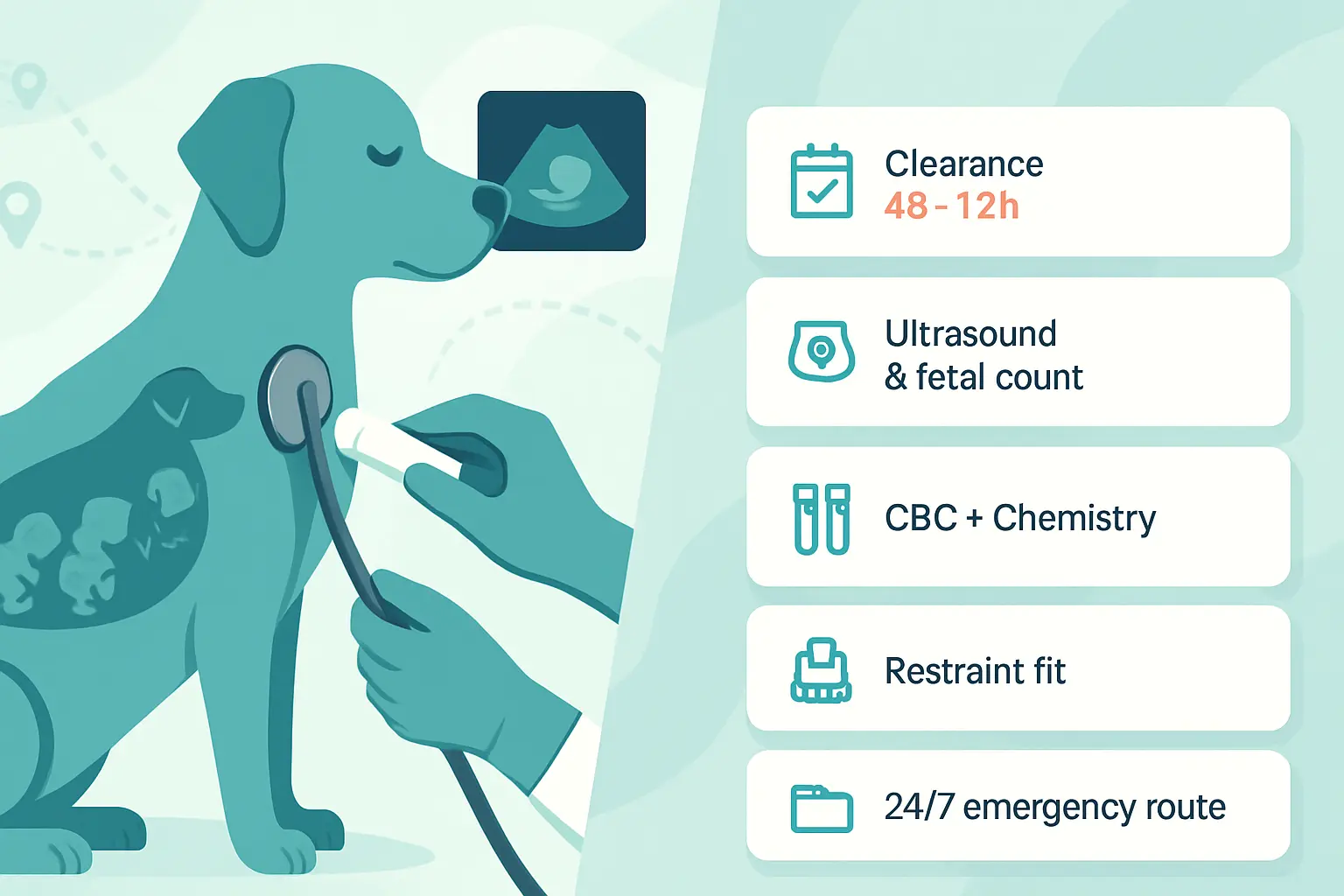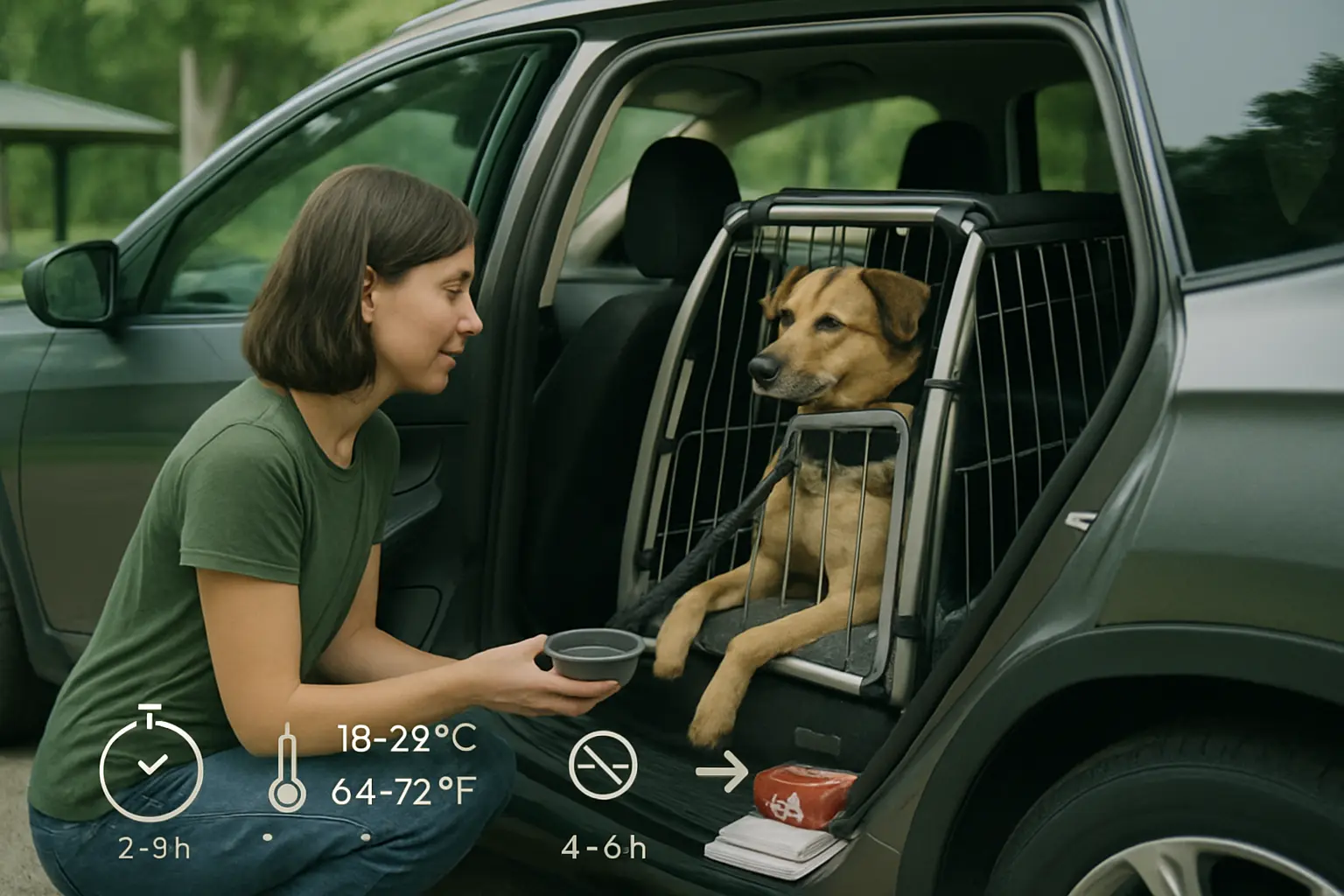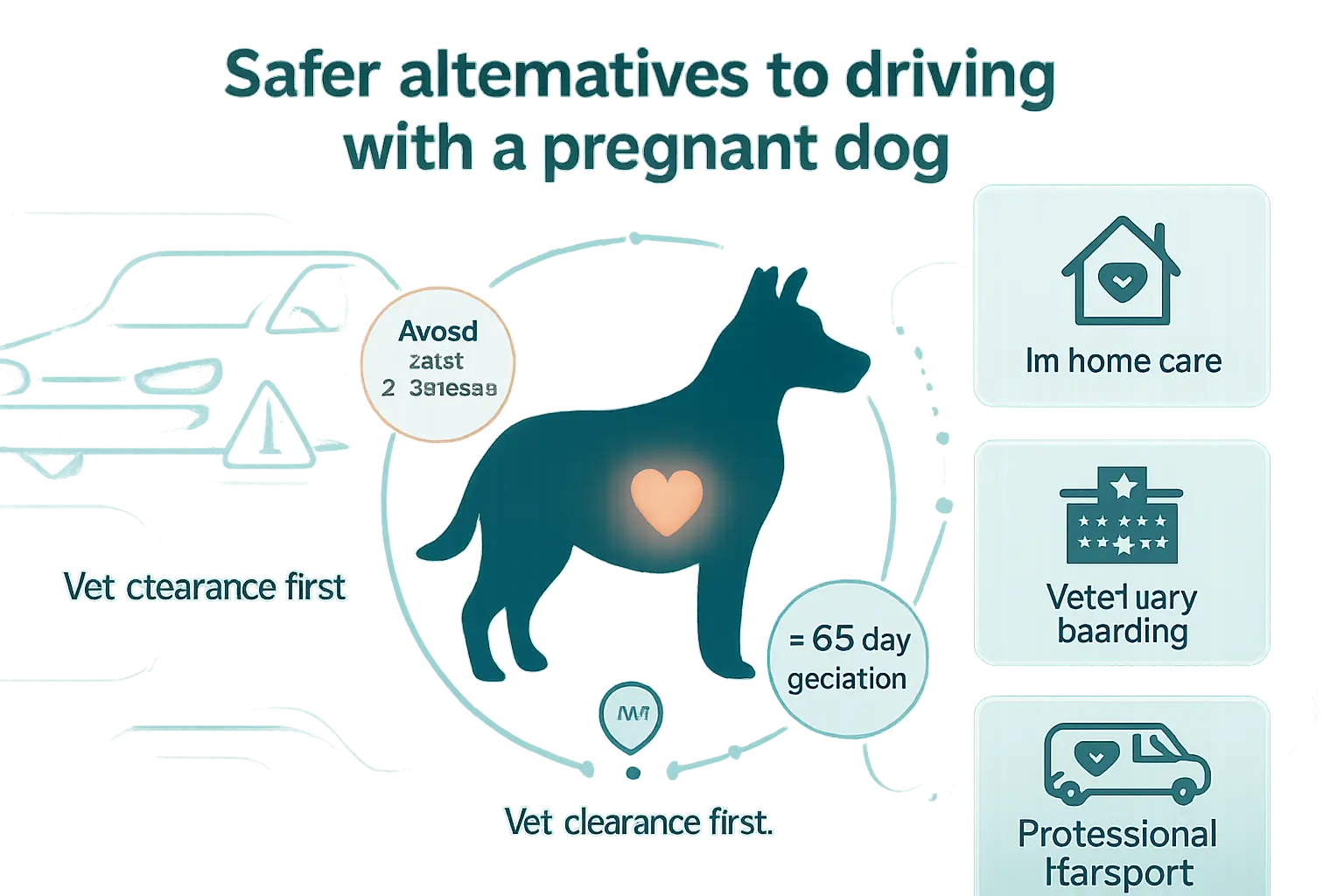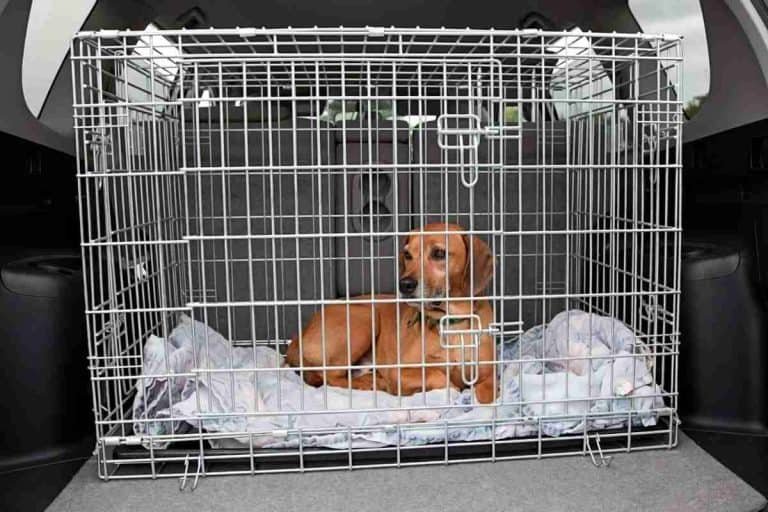Can a Pregnant Dog Travel by Car? Safety Guidelines, Timing, and Vet Advice
Affiliate Disclaimer: As an affiliate, we may earn a small commission when you make a purchase from any of the links on this page at no additional cost to you!
Last Updated on October 13, 2025
Can a pregnant dog travel by car? Yes—if timing, health, and planning align. Short, calm trips with vet clearance are usually safe. Avoid early implantation and the final weeks, when risks peak. Use secure restraint, maintain cool cabin temps, and schedule frequent stops. Map emergency clinics and carry records to handle surprises.
Find clear safety guidelines, smart timing windows, and practical vet advice to lower risk. Learn high‑risk red flags, legal pitfalls, and gear that keeps mom steady—plus checklists, emergency steps, and safer alternatives when travel should wait.
Is car travel safe for a pregnant dog?
Car travel can be safe for a pregnant dog, but safety depends on timing, the dog’s health, and trip logistics. A routine vet check and explicit clearance provide the best starting point. Pregnant dogs tolerate short, calm drives better than long, stressful journeys. Secure restraint, stable temperature control, and frequent stops reduce risk. A well-padded crate or a properly fitted canine seatbelt keeps the dam steady and lowers injury risk during sudden braking. Keep travel times brief and plan for water, shaded rest stops, and a quiet cabin environment to limit stress.
Owners should carry the dam’s medical records, a whelping kit, and the contact details of veterinarians along the route. If a breeder or veterinarian plans a scheduled C-section, postpone nonessential travel. For practical packing and safety gear ideas, consult essential dog travel tips and gear for road trips. Strongly consider a pre-trip exam and a written plan for emergencies before leaving. Schedule vet clearance no more than seven days before departure to ensure up-to-date assessment and clear instructions.
Main health and safety risks to consider
Owners must assess several medical and safety risks before driving with a pregnant dog. The most immediate dangers include premature labor triggered by stress or trauma, injury from sudden braking or collisions, and overheating in warm weather. Motion sickness can worsen nausea and dehydration in pregnant dogs, increasing the chance of complications. A cramped position for hours may reduce comfort and raise stress hormones, which can affect fetal wellbeing.
Other risks include vaginal bleeding, abdominal pain, and sudden weakness—signs that require urgent veterinary care. Bring supplies to stabilize the dam until help arrives: water, towels, and a thermal blanket. For motion-sickness strategies and calming measures, see guidance on making car rides easier for motion‑sick pups at how to make car rides enjoyable for your motion‑sick pup. If any concerning symptoms appear, stop the trip and seek immediate veterinary attention.
Which pregnancies are high-risk and when to avoid travel
Some pregnancies carry higher risks and justify avoiding travel entirely. Dogs with a history of dystocia, prior C-sections, or uterine abnormalities require stable access to their regular veterinarian or specialist. Breeds prone to birthing complications—such as brachycephalic and giant breeds—face greater danger during transport. Advanced maternal age, chronic illness, or poor body condition also increase risk.
A dog with ultrasound findings of fetal distress, low fetal heartbeat, or placental issues should not travel. Avoid trips during the final two to three weeks of gestation, when labor can start unexpectedly. If the breeder or vet schedules an elective C-section, the dam should remain in the location where surgery will occur. When transport is unavoidable, use a reinforced crate secured in the vehicle and have a clear emergency plan. For guidance on securing crates in cars, review tips on 5 ways to secure a dog crate in car.
Legal and practical reasons to postpone travel
Legal and logistical factors often outweigh marginal benefits of travel. Some jurisdictions have animal-transport rules requiring restraint or limiting how animals travel in a vehicle. Rental car companies and pet-friendly lodgings may enforce policies that complicate urgent veterinary access. A pregnant dog’s owner must confirm local regulations and accommodation pet policies before planning a trip.
Practical reasons to delay include lack of reliable veterinary care along the route, long distances from emergency hospitals, and extreme weather forecasts. If the trip prevents regular feeding, scheduled medications, or monitoring of the dam, postpone. Also consider liability: an injured pregnant dog during a crash could lead to costly emergency care or legal claims if the owner ignored clear risks. Check local transport rules and practice safe restraint; more on travel positioning and legal considerations can be found at are dogs allowed to travel in the footwell of a car. When in doubt, delay travel until a vet confirms safety.
Understanding canine pregnancy and risky timeframes
The question “Can a Pregnant Dog Travel by Car? Safety Guidelines, Timing, and Vet Advice” centers on timing and risk management. Owners must balance maternal comfort, fetal safety, and access to veterinary care before deciding to travel.
A pregnant dog faces two general risk zones: the early implantation phase and late gestation. Between those windows, short, well‑planned trips often remain possible with veterinary clearance. A veterinarian will evaluate the dog’s health, the litter size, and prior birthing history to give case‑specific advice.
Practical preparation reduces hazards. Carry medical records, a whelping kit, and contact details for emergency clinics along the route. Use secure restraints and climate control to limit motion stress and overheating. For checklists and travel gear suggestions, consult this guide to essential dog travel tips and gear for road trips.
If travel seems unavoidable, obtain written vet clearance and map emergency facilities ahead. When questions remain, prioritize a short stay at home or postpone travel until after whelping.
Short timeline of canine gestation and key milestones
Canine gestation lasts about 63 days from ovulation. Owners should track milestones to judge travel safety and recognize warning signs. Fertilization occurs within days of mating. Implantation follows roughly one to two weeks after mating.
Organ formation begins around weeks three to five. This stage represents critical development. Mid‑gestation (weeks four to seven) involves rapid fetal growth and weight gain in the mother. The final two weeks mark rapid maturation and preparation for labor. Signs of imminent whelping include nesting behavior, drop in body temperature, and decreased appetite.
Because puppies arrive quickly once labor begins, travel late in gestation poses a high logistical risk. For guidance on transporting very young dogs and related safety, see how to transport a puppy in a car without a crate. Owners should log mating dates, watch for behavioral changes, and let the timeline guide travel decisions.
High-risk windows (early implantation and late gestation) and why they matter
Early implantation and late gestation present the greatest dangers during car travel. In early pregnancy, embryos remain vulnerable to stress, toxins, and abrupt environmental changes. These factors can increase the chance of failed implantation or early pregnancy loss.
Late gestation carries risk of premature labor, placental problems, and dystocia. Motion, temperature swings, or delayed access to veterinary care can turn a routine trip into an emergency. Even routine discomfort may trigger early contractions in sensitive dogs.
Veterinarians commonly advise avoiding nonessential travel during the first three to four weeks and during the last two to three weeks of pregnancy. If travel cannot wait, plan shorter routes, frequent stops, and immediate access to emergency clinics. For tips on minimizing car stress and motion effects, consult the article about making car rides enjoyable for motion‑sick pups.
When in doubt, delay travel or arrange local boarding near a vet.
Breed- and age-related factors that change timing decisions
Breed and age alter pregnancy risk and influence travel recommendations. Brachycephalic breeds often struggle with breathing and heat regulation. These dogs handle car travel poorly, especially when late in pregnancy. Giant and molosser breeds face higher dystocia risk and need specialized obstetric planning.
Age matters. Very young bitches and senior females show higher complication rates. A history of cesarean sections, previous difficult births, or existing medical conditions raises the risk profile substantially. Litter size also affects travel advice; large litters increase maternal strain during transport.
Owners should disclose breed, age, and reproductive history to their veterinarian before planning any trip. For context on breed size and travel constraints, review information on dog breeds that fit under airplane seat.
When breed or age creates concern, schedule exams and obtain written travel clearance. If the vet recommends against travel, arrange alternatives near competent veterinary care.
What your veterinarian should check before any trip

The veterinarian must assess whether a pregnant dog can travel by car safely. They should confirm the stage of pregnancy and estimate the whelping date. Late pregnancy carries the highest risk for labor or complications during a drive. The vet will evaluate overall health, body condition, and hydration. They will also screen for conditions that increase travel risk, such as pre-eclampsia, infection, or chronic disease that could worsen with stress.
Discuss travel duration, road conditions, and whether the dog will be crated or restrained. The vet can advise on crate size and restraint type based on the dog’s size and pregnancy. Owners should bring recent vaccination and parasite-control records to the exam so the vet can verify protective coverage and identify any gaps that travel might exacerbate. Ask the clinic about local emergency services along the route and whether a pre-trip appointment within 48–72 hours of travel is recommended. For practical gear guidance, see essential dog travel tips and gear for road trips.
Pre-trip exam and diagnostic tests to request
The pre-trip exam should start with a full physical exam, including temperature, heart and lung auscultation, and abdominal palpation. For dogs near term, request an abdominal ultrasound to confirm fetal viability and count pups. Ultrasound can detect distress or placental problems that make travel unsafe. If the pregnancy timing is uncertain, a progesterone assay helps determine proximity to ovulation and expected whelping window.
Basic bloodwork—CBC and chemistry panel—checks for anemia, infection, kidney and liver function, and electrolyte balance. Dehydration or metabolic disturbances increase risks during travel. If the dog shows any respiratory signs, obtain thoracic radiographs or further cardiopulmonary workup. The veterinarian may also screen for common infectious diseases that compromise pregnancy. Discuss whether a short trial drive or supervised crate time at the clinic is useful to assess motion tolerance. For guidance on choosing an appropriate travel crate and securing it, consult the best dog crates for car travel.
Medications, preventives, and what NOT to give during pregnancy
A veterinarian should approve any medication before travel. Many common drugs can harm fetuses or alter labor timing. Avoid nonsteroidal anti-inflammatory drugs (NSAIDs) late in pregnancy unless the vet prescribes them for a specific, monitored reason. Certain antibiotics, like tetracyclines, can affect fetal development and should stay off the list unless necessary and vet-supervised.
Continue heartworm prevention and routine parasite control only under veterinary guidance. Many topical flea and tick products remain safe, but the vet will recommend specific brands and timing. Sedatives and heavy tranquilizers pose risks: they can depress respiration in both dam and fetuses and complicate emergency care. Treat motion sickness conservatively; the vet may recommend short-acting, pregnancy-safe options or behavioral measures. For non-drug strategies to reduce travel nausea and stress, see how to make car rides enjoyable for a motion-sick pup. Always bring a vet-approved medication list and dosing instructions when traveling.
Documentation and emergency vet planning
Before departure, compile a travel folder containing vaccination records, recent exam notes, ultrasound or bloodwork results, and the estimated due date. Include a printed list of current medications with dosages. Save the primary veterinarian and emergency clinic phone numbers on the phone and in the folder. Identify 24-hour emergency hospitals along the route and mark their locations using a mapping app. Confirm which clinics accept obstetric emergencies and have surgical capability.
Plan regular stops to check the dog, offer water, and allow brief, supervised relief. Secure the crate to prevent shifting in a sudden stop; practice crate loading and securing before the trip. For methods to secure a crate in a car, refer to 5 ways to secure a dog crate in car. Share the travel plan and emergency contacts with any travel companions. If the vet advises against travel, prioritize the dog’s safety and reschedule. If cleared, keep the vet’s recommendations accessible and call at the first sign of labor or distress.
Preparing your dog and vehicle for a safe drive
Before any trip, the owner should get veterinary clearance and a clear timeline for safe travel. Most vets advise avoiding nonessential drives in the last two to three weeks of gestation. The vehicle needs a safety check: brakes, tires, fluids, and functioning climate control. Prepare an emergency kit that includes the dog’s medical records, a tag with the breeder or vet contact, clean towels, extra collar and leash, absorbent pads, and a calibrated thermometer.
Plan routes with frequent, predictable stops for toileting and hydration. Map veterinary clinics along the route and note their hours. Keep driving segments short enough that the dog can lie down comfortably without pressure on her abdomen. The owner should reserve the most stable area of the vehicle—usually the cargo area of an SUV or a rear seat with proper restraint—and remove loose items that could shift during braking.
For general gear and packing recommendations, see essential dog travel tips and gear for road trips. Pack those items the night before the trip so nothing gets forgotten. A final vet check within 48 hours of departure provides the best safety margin.
Crates, seatbelt harnesses and proper restraint options
Choose a restraint that protects the dog in a sudden stop and avoids abdominal compression. A rigid, crash-tested crate sized so the dog can stand and turn comfortably works well for many pregnant dogs. Secure the crate to anchor points or seat belts to prevent sliding. If a crate isn’t practical, select a certified, padded seatbelt harness that distributes force across the chest and shoulders, not the belly.
Avoid harnesses or carriers that squeeze the ribcage or abdomen. Use barriers or a secured cargo crate in hatchback and SUV setups to create a stable, upright space. Test restraint fit: the dog should sit, stand, and lie down without pressure on the abdomen.
For comparisons and crate recommendations, consult best dog crates for car travel in 2023. The owner should try the chosen restraint on a short practice ride and bring the receipt in case of exchange. When in doubt, ask the veterinarian which restraint type suits the dog’s size and pregnancy stage.
Comfort, temperature control, bedding and familiar items
Maintain a stable cabin temperature between 18–22°C (64–72°F) for most breeds, and avoid direct drafts on the belly. Use breathable, low-profile bedding that cushions joints and supports the abdomen without sinking. Non-slip pads under the bedding keep the surface from shifting during turns.
Pack small, familiar items: a favorite blanket, a worn T-shirt with the owner’s scent, and a lightweight toy. These reduce stress and help the dog settle faster. Avoid heavy or heat-retaining materials; moisture-wicking or cooling pads work well in warm weather. Keep fresh water accessible and offer small amounts regularly to prevent dehydration.
Monitor for signs of overheating and stop if the dog pants excessively, drools heavily, or seems disoriented. For motion-sickness strategies and comfort tips, review no more doggie dramas: how to make car rides enjoyable for your motion sick pup. Owners should consult the vet before giving any anti-nausea medication or supplements.
Short practice rides and acclimation strategies
Begin acclimation with short, nonthreatening sessions. Have the dog explore the stationary car for several minutes, rewarding calm behavior with treats. Next, take brief drives of five to ten minutes on quiet roads. Gradually increase drive time and introduce predictable stopping points for toilet breaks and gentle praise.
Use positive reinforcement: treats, calm verbal cues, and a consistent pre-ride ritual. Practice crate or harness use during these short outings so the dog associates restraint with comfort and safety. Observe breathing, gait, and vocal cues during practice; any marked changes warrant a vet check.
For natural anxiety remedies and behavior-focused tips, see 9 natural ways to remedy your dog’s travel anxiety. Schedule a veterinary visit after the initial acclimation period if the dog shows persistent stress. A planned, gradual approach reduces risk and makes longer drives safer when necessary.
Practical care during the journey

Caregivers must plan travel around the pregnant dog’s comfort and safety. Small adjustments to breaks, feeding, and monitoring reduce risks and make the drive manageable for both dog and owner.
Scheduling breaks, toileting and hydration best practices
Plan stops every two to three hours, and more frequently during late pregnancy. Offer a short leash walk on firm ground for toileting and gentle stretching. Pack absorbent pads and a waterproof mat for unexpected accidents. Provide small amounts of water at each stop rather than free access in the car to avoid nausea or bladder discomfort. Keep a travel kit with clean towels, disposable gloves, and a spare collar or harness.
Managing motion sickness and feeding timing
Avoid feeding within four to six hours before departure to lower motion-sickness risk. Offer a light snack if travel lasts many hours. Ask a veterinarian about safe, prescription antiemetics or natural options such as small amounts of ginger—use only vet-approved remedies. Secure the dog facing forward in a crate or harness to reduce vestibular upset and keep the cabin cool and well-ventilated.
Monitoring mom for warning signs while on the road
Caregivers should watch for heavy vaginal bleeding, continuous contractions, severe panting, weakness, or a rectal temperature below 99°F—these require immediate veterinary attention. If any concerning sign appears, stop the trip, move the dog to a shaded, quiet area, and contact the veterinarian. For additional practical travel gear and tips, see essential dog travel tips and gear for road trips. CTA: schedule a pre-trip vet check when planning travel with a pregnant dog.
Recognizing emergencies and immediate steps to take
Pregnant dogs can develop sudden, life-threatening problems during travel. Handlers must recognize urgent signs and act quickly. Clear, calm steps reduce risk to both dam and pups.
Signs of labor, premature delivery, or fetal distress in transit
Early labor signs include restlessness, nesting, and a drop in rectal temperature about 24 hours before delivery. Active labor shows visible contractions and repeated straining. Concerning signs include strong straining for more than 30 minutes without a pup, green or black vaginal discharge, heavy bleeding, pale or blue gums, collapse, or lifeless puppies. Premature pups are very small, weak, or covered in meconium. Any of these indicate fetal distress or obstructed labor and require emergency care.
What to do if labor starts on the road or complications arise
Pull over safely and call a veterinarian or emergency clinic immediately. Keep the dog warm and as calm as possible. Create a clean, shaded space using towels and a carrier. If a puppy presents and the handler can see the sac, gently clear the airway with a towel and stimulate breathing. Never pull on a stuck puppy; instead, transport to the nearest emergency vet. When in doubt, prioritize rapid transport over home-style intervention.
What to include in a pet emergency kit and how to find emergency care
Pack a compact kit: clean towels, disposable gloves, digital thermometer, sterile scissors, gauze, vet wrap, syringe (no needle), warm packs, a flashlight, emergency contacts, and copies of vaccination and pregnancy records. Store the kit with travel gear and a secure crate. For locating emergency care, use local vet hotlines, map apps, or roadside vet directories. Handlers traveling often should review essential dog travel tips and gear for road trips to prepare routes and identify clinics along the way. Call an emergency clinic at the first sign of complication.
Safer alternatives to driving with a pregnant dog

Driving while a dog is pregnant raises risks such as stress, overheating, sudden labor, motion sickness, and injury from abrupt stops. When travel cannot be avoided, owners should weigh safer alternatives. Short trips for routine vet checks remain acceptable with veterinary clearance, but longer road journeys often do more harm than good. Options include arranging trusted in-home care, postponing nonessential travel until after whelping, or transferring care to professionals trained for pregnant animals. Each choice reduces exposure to traffic hazards and limits time away from a familiar environment, lowering the chance of preterm labor.
For owners committed to road travel, thorough preparation and the right gear cut risk. The site offering essential dog travel tips and gear for road trips provides guidance on safe restraint, temperature control, and packing medical supplies. Before choosing any alternative, obtain veterinary clearance and document the dog’s expected whelping date. That date should drive the decision: if travel falls inside the last two to three weeks of gestation, defer or arrange local care. A clear plan minimizes emergency moves that might endanger the dam and the litter.
Options for trusted caretakers, in-home sitting, or postponement
Trusted caretakers and in-home sitting preserve routine and reduce stress for a pregnant dog. Owners should select a caregiver with verified experience handling late-pregnancy dogs or newborn litters. Vet references, walkthroughs of the home, and a written care plan help ensure competence. The care plan should cover feeding schedule, exercise limits, temperature monitoring, signs of labor, and an emergency contact list, including the regular veterinarian and an emergency clinic.
When arranging in-home sitting, owners should stock a whelping box, clean towels, heating pads with thermostats, and basic supplies. Caregivers must know when to contact the owner or vet: prolonged straining without delivery, bloody-green discharge, or extreme lethargy require immediate attention. If a trusted caregiver is unavailable, postponement is often the safest option. Delaying travel until after the puppies arrive and stabilize spares the dam physical stress and lowers neonatal mortality. Owners should confirm postponement policies for lodging or transportation and secure veterinary recheck dates post-whelping.
When professional animal transport or veterinary boarding is appropriate
Professional animal transport or veterinary boarding suits situations where no trusted caregiver exists and travel remains necessary. Choose accredited transporters who specialize in medical or pregnant-animal moves. They must provide climate-controlled vehicles, trained staff, and contingency plans for labor en route. Transporters should accept veterinary directives and carry documentation of the dog’s health status and emergency contacts.
Veterinary boarding becomes appropriate when the dam needs close medical monitoring before or after delivery. Veterinary hospitals offer round-the-clock observation, IV fluids, and surgical capability if a cesarean becomes necessary. Owners should request a boarding pre-assessment, confirm monitoring frequency, ask about staffing overnight, and obtain a clear cost estimate for potential interventions. For reference on regulated transport practices and air-travel limitations, review resources such as airlines that allow dogs in the cargo to understand how carriers manage animal safety and documentation. Always secure written vet approval before booking any professional service.
Planning travel around the expected whelping date
Effective planning centers on the expected whelping date and a conservative buffer. Most veterinarians advise avoiding nonessential travel during the final three weeks of gestation. The safest window for necessary travel is typically the second trimester, when organogenesis is complete and mobility remains comfortable. Owners should calculate the due date from the breeding date or a vet-confirmed ultrasound.
When travel cannot be moved, schedule it at least four weeks before the expected whelping or four weeks after birth, once the dam and puppies receive a veterinary check and the puppies nurse well. Prepare an emergency kit with obstetric supplies, neonatal feeding tools, contact numbers, and a foldable whelping pad. Practice safe handling for getting the dog in and out of vehicles—especially with large breeds—by following techniques such as those described in 5 steps to safely lift a large dog into a car. Confirm route options with nearby emergency clinics and communicate the plan to any caregiver or transport service before departure. Finally, call the veterinarian for final clearance within 48 hours of travel.
Quick pre-trip checklist and pack list for pregnant dogs
Before any drive, confirm a veterinarian has cleared the dog for travel. Short trips earlier in pregnancy usually pose fewer risks than long trips late in gestation. Plan routes with frequent stops every 1–2 hours for water, bathroom breaks and gentle walks. Keep the car cool and ventilated; avoid direct sun on the abdomen.
Prepare a secure travel spot: a well-ventilated crate or a harnessed seat area that prevents sliding and pressure on the belly. Pack comfortable bedding, extra towels, and disposable pads to manage accidents. Bring enough familiar food and bottled water for the trip plus extra for delays. Avoid sedatives unless a vet prescribes them.
Include an emergency plan with estimated driving times to nearby veterinary clinics on the route. Save contacts and clinic addresses offline.
For broader road-trip gear and vehicle-preparation tips, see this essential dog travel tips and gear for road trips. Call the veterinarian the morning of departure if anything changes in the dog’s condition.
One-page go/no-go decision checklist
This one-page checklist helps decide quickly whether to travel. Use it at home and at staging points.
- Veterinary clearance obtained within 48 hours?
- Pregnancy stage: avoid travel after about 45–55 days for most breeds unless cleared?
- Any recent bleeding, discharge or contractions?
- Dog shows lethargy, fever, vomiting, or severe panting?
- Trip length under 3 hours with reliable rest-stop access?
- Route includes emergency clinics within reachable distance?
- Secure crate or harness available and tested?
- Temperature control available in vehicle?
- Owner able to stop frequently and assist if needed?
If any answer is “no” or uncertain, postpone travel and consult the veterinarian. For crate choice and sizing guidance related to car travel, consult a review like best dog crates for car travel.
Essential documents, meds and supplies to pack
Collect and organize critical paperwork and medical items in a waterproof folder or zip bag. Include:
- Veterinary certificate or written clearance and estimated due date.
- Vaccination and medical records with recent exam notes.
- Contact numbers for the primary vet and emergency clinics along the route.
- Prescription medications, measured syringes, and dosing instructions.
- Whelping basics: clean towels, disposable gloves, bulb syringe, and iodine solution.
- Digital thermometer and soft muzzle if restraint may be necessary.
- Familiar food, measured portions, and treats to reduce stress.
Avoid over-the-counter sedatives unless prescribed. Pack travel-size first-aid items and a flashlight. For additional transport tips and how to manage a dog without a crate when needed, see how to transport a puppy in a car without a crate. Keep documents accessible for quick handoff at clinics.
Post-trip follow-up: monitoring and when to call your vet
Monitor the dog closely for 48–72 hours after travel. Check behavior, appetite, temperature and breathing every 8–12 hours. Expect mild tiredness; persistent lethargy or loss of appetite warrants contact with the veterinarian.
Watch for warning signs that require immediate veterinary attention:
- Regular contractions before the expected due date.
- Profuse or bloody vaginal discharge.
- Fever above 104°F (40°C) or low body temperature.
- Persistent vomiting or refusal to drink for more than 12 hours.
- Extreme weakness, collapse, or difficulty breathing.
If motion sickness occurred, manage with hydration and rest. For tips on calming motion-sick dogs during and after travel, consult no more doggie dramas—car rides for motion-sick pups. Call the veterinarian immediately for any red-flag signs. If advised, transport directly to the nearest emergency clinic.
Summary
Car travel can be safe for a pregnant dog when timing, veterinary clearance, and careful preparation align. Short, calm trips during mid‑gestation are the lowest risk, while the early implantation period and the final two to three weeks before whelping carry the greatest danger. A written plan, secure restraint, climate control, and frequent breaks help protect both dam and pups.
Veterinarians should confirm pregnancy stage, evaluate risks, and approve any medications before departure. High‑risk pregnancies, extreme weather, limited access to emergency care, or scheduled C‑sections are strong reasons to postpone travel or choose alternatives such as in‑home care or veterinary boarding. If travel is necessary, pack emergency supplies, map 24/7 clinics along the route, and monitor for warning signs that demand immediate care.
Key Takeaways
- Timing matters: Avoid nonessential drives during the first 3–4 weeks and the last 2–3 weeks of pregnancy; if travel is unavoidable, plan it for mid‑gestation with veterinary clearance.
- Get vet clearance: Obtain written approval within the week of departure—ideally 48–72 hours before leaving—and follow case‑specific advice on restraint, route, and medications.
- Prioritize restraint and comfort: Use a crash‑tested crate secured to the vehicle or a padded seatbelt harness that avoids abdominal pressure; maintain 18–22°C (64–72°F) cabin temperature and schedule stops every 2–3 hours.
- Prepare for emergencies: Carry medical records and a whelping kit, pre‑identify 24/7 emergency clinics, and know red flags such as heavy bleeding, green/black discharge, strong straining without a pup, collapse, or abnormal temperature.
- Know high‑risk scenarios: Postpone travel for brachycephalic or giant breeds, prior dystocia/C‑section, chronic illness, advanced age, fetal distress on ultrasound, or when a C‑section is scheduled.
- Feed and motion‑sickness strategy: Avoid feeding 4–6 hours before departure, keep the dog forward‑facing with good ventilation, and use only vet‑approved antiemetics if needed.
FAQ
What is the safest time for a pregnant dog to travel by car? Short, planned trips during mid‑gestation are typically safest. Avoid nonessential travel during the first 3–4 weeks (implantation) and the last 2–3 weeks before the due date.
How soon before a trip should a veterinarian provide travel clearance? Aim for written clearance within the week of departure, ideally 48–72 hours before travel. This timing ensures up‑to‑date assessment and instructions.
What restraint should a pregnant dog use in the car? A crash‑tested, properly sized crate secured to the vehicle is preferred; a certified, padded seatbelt harness that distributes force across the chest and shoulders is an alternative. Avoid any restraint that compresses the abdomen.
How can owners reduce motion sickness and stress during the drive? Skip large meals for 4–6 hours pre‑trip, keep the cabin cool and well‑ventilated, face the dog forward, and take frequent breaks. Ask a veterinarian about safe, pregnancy‑appropriate antiemetics or behavioral strategies.
What emergency signs during travel require immediate veterinary care? Heavy or green/black discharge, strong straining for over 30 minutes without a pup, pale or blue gums, collapse or severe weakness, fever above 104°F or temperature below 99°F, and persistent severe panting warrant urgent evaluation.







